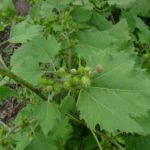| Common Name: |
Cocklebur |
| Botanical Name: |
Xanthium strumarium |
| Genus: |
Xanthium |
| Family: |
Asteraceae |
| Native Location: |
Europe to E Asia, widely naturalized. |
| Cultivation: |
Poordry soil in sun. Subject to statutory control as a weed in some countries, notably in parts of Australia. |
| Propagation: |
By seed sown in autumn or spring. |
| Harvest: |
Fruits are collected when ripe and dried for use in decoctions. |
| Height: |
20cm-1m (8-36in) |
| Width: |
10-60cm (4-24in) |
| Hardiness: |
Hardy |
| Parts Used: |
Fruits (cang er zi) |
| Properties: |
A pleasant-tasting, warming herb that relieves pain, relaxes spasms, and has anti-bacterial, anti-fungal, and anti-rheumatic effects. |
| Medicinal Uses: |
Internally for allergic rhinitis, sinusitis, mucus, rheumatism, rheumatoid arthritis, lumbago, leprosy, and pruritis. Externally for pruritis. |
| Bibliography: |
Encyclopedia of herbs by Deni Brown Copyright © 1995, 2001 Dorling Kindersley Limited. pp 408-409 |

